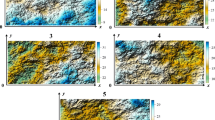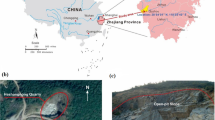Summary
It is argued that the currently available joint models are incapable of accurate predictions of joint shear behaviour without resorting to substantial levels of empiricism. This is because these models fail to adequately quantify joint roughness, or appreciate the importance of scale. A novel approach, which uses fractal geometry to investigate joint roughness, is described. This approach goes beyond describing the “symptoms” of roughness and seeks to find the “cause”. In the application of this approach, the concepts of fractal geometry, fractal dimension and self similarity are described and used as a framework to formulate a statistically based and practical model for the characterisation of rock joint roughness. Important relationships between the fractal dimension and the more useful statistical parameters of standard deviation of both asperity angles and asperity heights are derived. These relationships not only provide a useful, working method for quantifying joint roughness, but are also shown to provide a basis for understanding the Barton empirical JRC-JCS model. In addition, the fractal model is able to provide conceptual models for the effects of normal stress on the shear behaviour of joints and the scale-dependence of joints.
Similar content being viewed by others
References
Bandis, S., Lumsden, A. C., Barton, N. R. (1981): Experimental studies of scale effects on the shear behaviour of rock joints. Int. J. Rock Mech. Min. Sci. Geomech. Abstr. (18), 1–21.
Bandis, S., Lumsden, A. C., Barton, N. R. (1983): Fundamentals of rock joint deformation. Int. J. Rock Mech. Min. Sci. Geomech. Abstr. 20 (6), 249–268.
Barton, N., Bandis, S. (1982): Effects of block size on the shear behaviour of jointed rock. 23rd U.S. Symp. on Rock Mechanics, Berkeley, CA, 739–760.
Barton, N., Bandis, S. (1990): Review of predictive capabilities of JRC-JCS model in engineering practice. In: Proc., Int. Symp. on Rock Joints, Loen, Norway, Balkema, Rotterdam.
Barton, N., Choubey, V. (1977): The shear strength of rock joints in theory and practice. Rock Mech. 10, 1–54.
Brown, S. R. (1987): A note on the description of surface roughness using fractal dimension. Geophysical Research Letters 14 (11), 1095–1098.
Carr, J. R., Warriner, J. B. (1987): Rock mass classification using fractal dimension. In: Proc., 28th U.S. Symposium on Rock Mechanics, Tucson, Balkema, Rotterdam, 73–80.
Feker, E., Rengers, N. (1971): Measurement of large scale roughness of rock planes by means of profilograph and geological compass. Rock fracture, In: Proc., Int. Symp. on Rock Mechanics, Nancy.
Haberfield, C. M., Johnston, I. W. (1994): A mechanistically based model for rough rock joints. Accepted for publication Int. J. Rock Mech. Min. Sci. Geomech. Abstr.
Huang, S. L., Oelfke, S. M., Speck, R. C. (1992): Applicability of fractal characterization and modelling to rock joint profiles. Int. J. Rock Mech. Min. Sci. Geomech. Abstr. 29 (2), 89–98.
ISRM (1978): Suggested methods for the quantitative description of discontinuities in rock masses. Int. J. Rock Mech. Min. Sci. 15 (6), 319–368.
Kaye, B. H. (1989): A random walk through fractal dimensions, VCH Weinheim.
Kodikara, J. K. (1989): Shear behaviour of rock-concrete joints and side resistance of piles in weak rock. PhD Dissertation, Dept. of Civil Engng., Monash University.
Koura, M. M., Omar, M. A. (1981): The effect of surface parameters on friction. Wear 73, 235–246.
Krahn, J., Morgenstern, N. R. (1979): The ultimate frictional resistance of rock discontinuities. Int. J. Rock Mech. Min. Sci. 16, 127–133.
Lam, T. S. K. (1983): Shear behaviour of concrete-rock joints. PhD Dissertation, Dept. of Civil Engng., Monash University.
Lee, Y. H., Carr, J. R., Barr, D. J., Haas, C. J. (1990): The fractal dimension as a measure of the roughness of rock discontinuity profiles. Int. J. Rock Mech. Min. Sci. Geomech. Abstr. 27 (6), 453–464.
Leong, E. C., Randolph, M. F. (1992): A model for rock interfacial behaviour. Rock Mech. Rock Engng. 25 (3) 187–206.
Logan, J. M., Teufel, L. W. (1986): Effect of normal stress on the real area of contact. Pure Appl. Geophys. 124 (3), 471–485.
Mandelbrot, B. B. (1977): Fractals: form, chance and dimension, Freeman, San Francisco.
Mandelbrot, B. B. (1983): The fractal geometry of nature, Freeman, San Francisco.
Mandelbrot, B. B. (1985): Self-affine fractals and fractal dimensions. Physica Scripta 32, 257–260.
Patton, F. D. (1966): Multiple modes of shear failure in rock. In: Proc., 1st Congress Int. Soc. Rock Mechanics, Lisbon, 1, 509–513.
Reeves, M. J. (1985): Rock surface roughness and frictional strength. Int. J. Rock Mech. Min. Sci. Geomech. Abstr. 22 (6), 429–442.
Rengers, N. (1970): Influence of surface roughness on the friction properties of rock planes. In: Proc., 2nd Congress Int. Soc. Rock Mechanics, Belgrade, 1, 1–31.
Richardson, L. F. (1961): The problem of contiguity: an appendix of statistics of deadly quarrels. General Systems Yearbook 6, 139–187.
Seidel, J. P. (1993): The analysis and design of pile shafts in weak rock. PhD Dissertation, Dept. of Civil Engng., Monash University.
Stevens, R. F. (1990): Fractal programming in Turbo Pascal, M and T Publishing Inc., Redwood City, CA.
Tse, R., Cruden, D. M. (1979): Estimating joint roughness coefficients. Int. J. Rock Mech. Min. Sci. 16, 303–307.
Turk, N., Greig, M. J., Dearman, W. R., Amin, F. F. (1987): Characterization of rock joint surfaces by fractal dimension. In: Proc., 28th U.S. Symp. on Rock Mechanics, Tucson, Balkema, Rotterdam, 1223–1236.
Williams, A. F. (1980): The design and performance of piles socketed into weak rock. PhD Dissertation, Dept. Civil Engng., Monash University.
Wu, T. H., Ali, E. M. (1978): Statistical representation of joint roughness. Int. J. Rock Mech. Min. Sci. 15 (5), 259–262.
Yu, X., Vayassade, B. (1991): Joint profiles and their roughness parameters. Int. J. Rock Mech. Min. Sci. Geomech. Abstr. 28 (4), 333–336.
Author information
Authors and Affiliations
Rights and permissions
About this article
Cite this article
Seidel, J.P., Haberfield, C.M. Towards an understanding of joint roughness. Rock Mech Rock Engng 28, 69–92 (1995). https://doi.org/10.1007/BF01020062
Issue Date:
DOI: https://doi.org/10.1007/BF01020062




